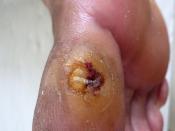Adult Onset Diabetes Diabetes has been recognized for thousands of years as a disease. The Ebers Papyrus, an ancient Egyptian text written around 1550 B.C., described a condition of passing too much urine. Diabetes was given its name in the second century A.D. by a Greek physician Aretaeus. It was named for a Greek word meaning to "siphon"� or "pass through"�. Early on it was observed that urine from people with diabetes was sweet. They concluded this by pouring the urine near an anthill. If the urine contained sugar the ants were attracted to it. In the eighteenth century the word mellitus was added to describe the sugary taste. Later on in the twentieth century Professor J.J.R. McCleod teamed with Dr. Frederick Banting and a young medical student named Charles Best. They succeeded in isolating the pancreatic islets (islets of Langerhans) and broke them down to find the substance that lowers glucose levels, or insulin.
They saved a fourteen-year-old boy who was dying from diabetes, with injections of insulin. They received the Nobel Prize in Medicine for the discovery of a procedure that is still in use today.
Diabetes is a disease that affects over 16 million Americans. It is the fourth leading cause of death by disease and the leading cause of kidney failure, blindness, and lower leg amputations. The incidence of heart attack and stroke in individuals with diabetes is two to four times that of the general population. The incidence of diabetes is steadily increasing and will affect nearly 20 million Americans by the year 2002. One of the most significant contributing risk factors for the development of diabetes is age. There is an increase in the prevalence of diabetes with age. Other risk factors include family history, obesity and inactive lifestyle. You cannot control your genetics...


